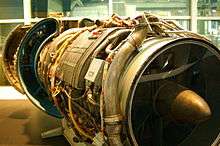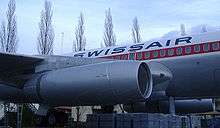General Electric CJ805
| CJ805 | |
|---|---|
 | |
| A CJ805-3A turbojet installed on a Convair 880 airliner | |
| Type | Turbojet (CJ805) Turbofan (CJ805-23) |
| National origin | United States |
| Manufacturer | General Electric Aircraft Engines |
| Major applications | CJ805: Convair 880 CJ805-23: Convair 990 |
| Developed from | General Electric J79 |


The General Electric CJ805 is a jet engine which was developed by GE Aviation in the late 1950s. It was a civilian version of the J79 and differed only in detail.[1] It was developed in two versions. The basic CJ805-3 was a turbojet and powered the Convair 880, while CJ805-23 (military designation TF35), a turbofan derivative, powered the Convair 990 airliners.
Design and development
CJ805-3
The CJ805-3 engine was General Electric's entry into the commercial engine business. Its application, the Convair 880, followed very soon after the military J79, on which it was based, entered service. An RB-66, with CJ805-3 engines installed, gained experience for airline use by flying simulated airline routes.[2]
The engine was fitted with a thrust reverser and noise-suppressing nozzle. Focus on commercial jet engine noise, and the requirement for noise suppressors, was very real before the Boeing 707 went into service 2 years before the Convair 880. There was already a lawsuit, by residents around Newark airport, concerning the noise from existing propeller-driven aircraft such as the Super Constellation, Stratocruiser and DC-7C.[3]
CJ805-23
Transatlantic service needed a higher thrust version of the existing turbojet and a demonstrator engine with a single-stage front fan attached to the compressor was run. It was difficult to start and operate. This experience led to the aft-fan[4] which didn't compromise the operation of the gas generator.
Although nowhere near as successful as the Pratt & Whitney JT3D, the CJ805-23 was a very advanced engine for its time (late 50's). Like the JT3D, the CJ805-23 was a turbofan derived from a turbojet. General Electric's approach was to take the single spool CJ805-3 turbojet and incorporate an aft fan/turbine system into the exhaust system. Each turbine blade was an integral part of a blucket, the outboard section of which was a fan rotor blade.[5] Running freely on a stub shaft, a series of bluckets, mounted on a disc, made up the aft rotor assembly. The efflux from the turbojet expanded through the (inner) turbine annulus. thus providing power directly to the fan blades located in the outer annulus. A full-length cowl, an annular exhaust system and a bucket thrust-reverser were fitted for the Convair 990.[6] A relatively short fan cowl and thrust reverser [7] was used to demonstrate the engine on the Sud Aviation Caravelle. The CJ805-23, if chosen, would have replaced the Rolls-Royce Avon. Rolls-Royce quickly built and tested an aft-fan demonstrator Avon to compete with the greater thrust and lower sfc of the CJ805-23. In the end the Caravelle was re-engined with the P&W JT8D turbofan.[8]
A similar short cowl arrangement to that demonstrated on the Caravelle had been employed on the Metropolitan-Vickers F.3, during WW2.
The unique feature of the -23 was the transonic single stage fan .[9] NACA had done a lot of research on multistage transonic compressors during the 50's. Using this data, GE decided to design and test a high pressure ratio single stage transonic fan. Much to their amazement the unit more than met the design target, including that of high efficiency. A modified version of this research unit was subsequently incorporated into the CJ805-23 aft fan. With no experience of transonic fan design and little time available, Pratt & Whitney had to resort to using 2 fan stages to produce a similar pressure ratio for their JT-3D turbofan. Although not an overhung design, the -23 transonic fan did not require any inlet guide vanes. There was, however, a series of structural vanes to help support the fan casing .[10]
The CJ805 program was not a commercial success.[11] However, extensive resources were put into improving the durability to make it suitable for airline service.[12] This led to a smaller aft-fan engine, the General Electric CF700, used in the Dassault Falcon 20 business jet.
At the same time the lift fan technology used in the XV-5 Vertifan was being developed into a high thrust cruise fan for the Lockheed C-5 Galaxy.[13]
Variants and applications
- CJ805-3
- Convair 880[14]
- CJ805-3A
- Convair 880-22 : Revised variable inlet guide vane and stator control.[14]
- CJ805-3B
- Convair 880-22M : Increased thrust.[14]
- CJ805-23
- Flight testing in a Douglas RB-66: Aft-fan variant with a direct drive fan attached to a free-running LP turbine.[14]
- CJ805-23A
- [14]
- CJ805-23B
- Convair 990[14]
- CJ805-23C
- Intended for the proposed Sud Aviation Caravelle 10A[14]
Only a single Sud Aviation Caravelle intended as a prototype for the US market, was equipped with the CJ805.
Specifications (CJ805-3B)
Data from FAA Type Certificate Data Sheet, E-306
General characteristics
- Type: Single-spool turbojet
- Length: 188.9 in (4,798 mm) with thrust reverser/suppressor
- Diameter: 31.6 in (803 mm)
- Dry weight: 3,213 lb (1,457 kg) with thrust reverser/suppressor
Components
- Compressor: 17-stage axial flow
- Combustors: can-annular
- Turbine: 2× gas generator power stages
- Fuel type: Aviation kerosene
- Oil system: pressure spray/splash
Performance
- Maximum thrust: 11,650 lbf (51.82 kN) for take-off
- Overall pressure ratio: 13:1
- Air mass flow: 167.9 lb/sec (76.16 kg/sec)
- Turbine inlet temperature: ~1205K
- Specific fuel consumption: 0.784 lb/lb·hr (22.21 g/s/kN)
- Thrust-to-weight ratio: 3.626 lbf/lb (0.0356 kN/kg)
Specifications (CJ805-23B)
General characteristics
- Type: Aft fan unmixed turbofan
- Length: 139 in (3,531 mm)
- Diameter: 53 in (1,346 mm)
- Dry weight: 3,730 lb (1,692 kg)
Components
- Compressor: 17-stage axial flow
- Combustors: can-annular
- Turbine: 2× gas generator power stages + 1× free running turbine with fan blades on the periphery
- Fuel type: Aviation kerosene
- Oil system: pressure spray/splash
Performance
- Maximum thrust: 16,100 lbf (71.62 kN) for take-off
- Overall pressure ratio: 13:1
- Air mass flow: 426lb/sec (193.2 kg/sec)
- Turbine inlet temperature: ~1205K
- Specific fuel consumption: 0.56 lb/lb·hr (15.86 g/s/kN)
- Thrust-to-weight ratio: 4.316 lbf/lb (0.0423 kN/kg)
See also
- Related development
- Related lists
References
Notes
- ↑ https://www.flightglobal.com/pdfarchive/view/1960/1960%20-%200381.html
- ↑ "Starting Something Big The Commercial Emergence of GE Aircraft Engines' Robert Garvin, AIAA Inc. 1998, ISBN 1-56347-289-9, p.20/21
- ↑ https://www.google.ca/search?q=the+noisy+dawn+of+the+jet+age&ie=utf-8&oe=utf-8&gws_rd=cr&ei=K6MSV5StCMj1jgSs-6uACA
- ↑ "Starting Something Big The Commercial Emergence of GE Aircraft Engines' Robert Garvin, AIAA Inc. 1998, ISBN 1-56347-289-9, p.16
- ↑ https://www.flightglobal.com/pdfarchive/view/1959/1959%20-%202802.html Fig7
- ↑ https://www.flightglobal.com/pdfarchive/view/1959/1959%20-%202802.html Fig8
- ↑ https://www.flightglobal.com/pdfarchive/view/1961/1961%20-%200787.html
- ↑ Rolls-Royce Aero Engines" Bill Guuston, Patrick Stephens Ltd. 1989, ISBN 1-85260-037-3, p.142
- ↑ Atmospheric Flight in the Twentieth Century: The Turbofan Emerges: GE's CJ805-23 Aft Fan Engine | url = https://books.google.com/books?id=qfrOBgAAQBAJ&pg=PT207&dq=CJ805-23&hl=en&sa=X&ved=0ahUKEwiUxp-xlv_KAhXDMBoKHb4iCh8Q6AEIHDAA#v=onepage&q=CJ805-23&f=false | accessdate = 2016-02-17
- ↑ 3D sectional view of CJ805-23 | url = http://i.imgur.com/dblhD.gif | accessdate = 2016-02-18
- ↑ "Starting Something Big The Commercial Emergence of GE Aircraft Engines' Robert Garvin, AIAA Inc. 1998, ISBN 1-56347-289-9, p.22
- ↑ "The Power to Fly" Brian Rowe, Pen & Sword Aviation 2005, ISBN 1 84415 200 6, p.41
- ↑ "The Power to Fly" Brian Rowe, Pen & Sword Aviation 2005, ISBN 1 84415 200 6, p.25
- 1 2 3 4 5 6 7 Taylor, John W.R. FRHistS. ARAeS (1962). Jane's All the World's Aircraft 1962-63. London: Sampson, Low, Marston & Co Ltd.
Bibliography
- Gunston, Bill (2006). World Encyclopedia of Aero Engines, 5th Edition. Phoenix Mill, Gloucestershire, England, UK: Sutton Publishing Limited. ISBN 0-7509-4479-X.
- Neumann, Gerhard (June 1984). Herman the German. William Morrow & Co. p. 269. ISBN 0-688-01682-0.
The former enemy alien and Air Corps G.I. whose inventive skills and maverick management techniques made jet engine history
External links
| Wikimedia Commons has media related to General Electric CJ805. |
- General Electric Aviation, J79 page
- GE: The History of Aircraft Engines (CJ805 mentioned)
- Animation of J79 turbojet (German language)
